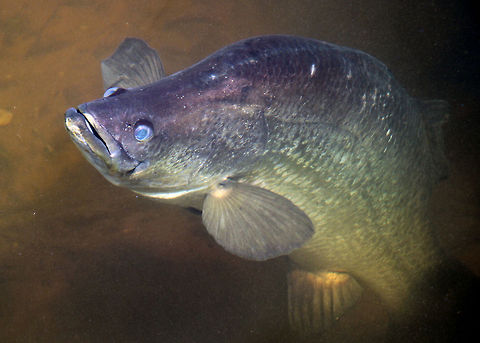
Appearance
This species has an elongated body form with a large, slightly oblique mouth and an upper jaw extending behind the eye. The lower edge of the preoperculum is serrated with a strong spine at its angle; the operculum has a small spine and a serrated flap above the origin of the lateral line. Its scales are ctenoid.In cross section, the fish is compressed and the dorsal head profile clearly concave. The single dorsal and ventral fins have spines and soft rays; the paired pectoral and pelvic fins have soft rays only; and the caudal fin has soft rays and is truncate and rounded.
Barramundi are salt and freshwater sportfish, targeted by many. They have large, silver scales, which may become darker or lighter, depending on their environments. Their bodies can reach up to 1.8 m long, though evidence of them being caught at this size is scarce. The maximum weight is about 60 kg. The average length is about 0.6-1.2 m.
Barramundi are demersal, inhabiting coastal waters, estuaries, lagoons, and rivers; they are found in clear to turbid water, usually within a temperature range of 26−30°C. This species does not undertake extensive migrations within or between river systems, which has presumably influenced establishment of genetically distinct stocks in Northern Australia.
Naming
Barramundi is a loanword from an Australian Aboriginal language of the Rockhampton area in Queensland meaning "large-scaled river fish". Originally, the name barramundi referred to saratoga and Gulf saratoga....hieroglyph snipped...However, the name was appropriated for marketing reasons during the 1980s, a decision which has aided in raising the profile of this fish significantly. "L. calcarifer" is broadly referred to as Asian seabass by the international scientific community, but is also known as Australian seabass, and by a variety of names in other languages, such as "ikan siakap" in Malay, "ikan kakap putih" in Indonesian, "apahap" in Tagalog, and "pla kapong" in Thailand.
Behavior
The barramundi feeds on crustaceans, molluscs, and smaller fish; juveniles feed on zooplankton.The barramundi is euryhaline, but stenothermal. It inhabits rivers and descends to estuaries and tidal flats to spawn. In areas remote from fresh water, purely marine populations may become established.
At the start of the monsoon, males migrate downriver to meet females, which lay very large numbers of eggs. The adults do not guard the eggs or the fry, which require brackish water to develop.
The species is sequentially hermaphroditic, with most individuals maturing as males and becoming female after at least one spawning season; most of the larger specimens are therefore female. Fish held in captivity sometimes demonstrate features atypical of fish in the wild: they change sex at a smaller size, exhibit a higher proportion of protogyny and some males do not undergo sexual inversion.
Food
Barramundi have a mild flavour and a white, flaky flesh, with varying amount of body fat.In Australia, barramundi is an iconic table fish revered as a quintessential Australian brand. Its name is, after all, derived from an Australian Aboriginal name. However, such is the demand for the fish that a substantial amount of barramundi consumed in Australia is actually imported. This has placed significant economic pressure on Australian producers, both fishers and farmers, whose costs are significantly greater due to remoteness of many of the farming and fishing sites, as well as stringent environmental and food safety standards placed on them by government. While country of origin labelling has given consumers greater certainty over the origins of their barramundi at the retail level, no requirement exists for the food service and restaurant trades to label the origins of their barramundi.
Barramundi are a favourite food of the region's apex predator, saltwater crocodiles, which have been known to take them from unwary fishermen.
Nile perch—a similar fish found in the Afrotropic ecozone, or sub-Saharan Africa—is often mislabeled as barramundi. It does not fall under the recommendation for US-farmed barramundi.
Cultural
The fish is of large commercial importance; it is fished internationally and raised in aquaculture in Australia, Saudi Arabia,Malaysia, India, Indonesia, Vietnam, Israel, Thailand, the United States, Poland, and the U.K.The Australian barramundi industry is relatively established, with an annual production of more than 4000 tons. In the broader Southeast Asian region, production is estimated to exceed 30,000 tons. By contrast, the US industry produces about 800 tons a year from a single facility.
Barramundi under culture will commonly grow from a hatchery juvenile, between 50 and 100 mm in length, to a table size of 400-600 g within 12 months and to 3.0 kg within 18–24 months.
References:
Some text fragments are auto parsed from Wikipedia.